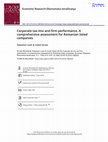Papers by Sebastian Lazar

Annals of Faculty of Economics, 2015
Using a fixed effects panel data estimation model in order to account for individual firm heterog... more Using a fixed effects panel data estimation model in order to account for individual firm heterogeneity, the paper investigates the determinants of corporate tax payments for Romanian non-financial companies listed at Bucharest Stock Exchange over twelve years period (2000 – 2011), adopting a new approach, the natural logarithms of corporate income taxes actually paid as dependent variable. This removes the inherent flaws of firm specific effective tax rates, while establishing a more comparable field for subsequent similar research. All the determinants investigated were found as having an impact, albeit at different level of significance. Capital intensity, leverage and labour intensity were found as having a negative effect, while profitability and size have a positive impact. The findings correspond in general to conventional theory. Moreover, the paper produces evidence concerning the impact of loss carry-forward provisions on firm tax payments.

Annals of Faculty of Economics, 2016
The paper investigates if size has any influence on firm performance for all non-financial compan... more The paper investigates if size has any influence on firm performance for all non-financial companies listed at Bucharest Stock Exchange over 12 years period. The proxies for firm size were total assets, sales and number of employees. Control variables were tangibles, leverage, labour intensity, sales growth and company value added. Using a fixed effects panel data estimation model in order to account for individual firm heterogeneity, the paper finds a negative effect of firm size on corporate performance, when size is expressed in total assets and sales and no effect at all when number of employees is used as a proxy for size. Also, tangibles, leverage and labour intensity display a negative sign, the only positive determinants being sales growth and company value added. The findings suggest that the asset mix Romanian listed is not performance driving oriented, but is under the influence of the large amount of real-estate assets which are not directly involved in producing goods (...

Economic Research-Ekonomska Istraživanja, 2021
The paper investigates the impact of loan loss provisions (LLPs) on bank-specific effective tax r... more The paper investigates the impact of loan loss provisions (LLPs) on bank-specific effective tax rates (ETRs) using data of 2943 banks from European Union during 2007-2014.As control variables we used size, equity, fixed assets and return on assets (ROA), while the specific country-year tax reforms were captured using Devereux-Griffith effective tax rates. The results prove robust to different model estimators and sample selections, which suggests that LLPs act systematically towards the reduction of the bank entities' corporate tax burden. When distinguishing between two banking business models, respectively shareholders-value (commercial banks) and stakeholders-value banks (savings and cooperative banks), empirical findings indicate that provisions negatively affects the former (commercial banks) specific ETRs, whereas for the latter (savings and cooperative banks), no statistical significant effect was detected. From policy perspective, in the context of the switch from the incurred-loss model to the expected-loss model with respect to LLPs (IFRS 9), this may signal additional tax bill reduction for bank entities, if decision makers fail to react promptly. Finally, looking at types of banks investigated, the results show that among all three categories of banks, commercial banks manage to avoid the increase of tax bill driven by some bank-specific determinants (i.e. ROA), while maximizing the tax savings driven by others (i.e. capital intensity), thus suggesting more tax planning oriented behaviour as compared to savings and cooperative banks.

Emerging Markets Finance and Trade, 2018
The article investigates the impact of widely accepted private vices (smoking and alcohol and gas... more The article investigates the impact of widely accepted private vices (smoking and alcohol and gasoline consumption) on public finance. Introducing the concept of "vice-related deficit," which aggregates the positive effects on public finance on the revenue side (cash inflows) and the negative effects on the expenditures side (cash outflows), the article looks upon cigarette, alcohol, and gasoline consumption as determinants of vice-related deficit for a number of 68 countries for year 2012. We found that smoking had a negative effect on vice-related budget balance, while alcohol and gasoline consumption had a positive effect. As control variables, we used life expectancy and size of the economy, both having been found with negative effects. The results prove robust to different sample adjustments. We also found that the negative effect of private vices on public finance is stronger for Christian countries than for non-Christian countries. Policy recommendations were made accordingly.
SSRN Electronic Journal, 2018

Economic Research-Ekonomska Istraživanja, 2018
The paper investigates the impact of overall firm-specific tax-mix on firm performance for Romani... more The paper investigates the impact of overall firm-specific tax-mix on firm performance for Romanian listed companies during the 2000-2011 period. By overall tax-mix, we mean all public finance-related liabilities borne by a company, thus including not only profit taxes, but also non-profit taxes (i.e., real-estate taxes) and labour-related taxes (social security charges borne by companies). Developed around the corresponding tax wedge, the variable of interest is a firmspecific effective tax rate that aggregates all public finance liabilities, based on a unique set of hand-collected data from publicly available corporate reports. Using a fixed-effect model, the results show that one percentage point increase in overall firm-specific tax rate triggers 0.15 percentage points decrease in return on assets. Moreover, tangibles, leverage and size have a negative effect on Romanian listed companies' performance, while liquidity, growth and lagged profitability have a positive effect. 'Doing Business/Paying Taxes' methodology developed by PricewaterhouseCoopers and World Bank. According to this, countries are ranked on the three indicators total tax rate, number of tax payments and time to comply. The larger these figures are, the larger the negative effects of taxation on business are. Since many indigenous surveys (C.N.I.M.P.M.M. [Consiliul National al Intreprinderilor Private Mici si Mijlocii], 2012) as well as widely acknowledged international surveys (World Economic Forum, 2011) identify taxation as one of the main barriers against business in Romania, this paper empirically investigates the effects of taxation on Romanian firms' performance. In doing so, a unique dataset which contains not only profit taxes, but also nonprofit taxes and labour-related taxes for all non-financial companies listed at the Bucharest
Emerging Markets Finance and Trade, 2014
ABSTRACT

Scientific Annals of Economics and Business, 2016
This paper analyses public finances sustainability in the Republic of Moldova under the European ... more This paper analyses public finances sustainability in the Republic of Moldova under the European Union fiscal rules, by estimating the structural budget balance indicator using a three steps methodology. We concluded that, except for 2009, the Republic of Moldova complies with the Maastricht numerical fiscal rule; however it does not comply with the new fiscal rules regarding the structural deficit and public expenditures growth that had been set by the Fiscal Compact. The fact that budget deficits and public debt had been sustainable was mainly because of the concessions made by the external creditors in restructuring the public debt and was not a merit of national government. Moreover, since the regular budget deficit and the structural one tell different stories, we strongly advocate for using the latter in order to complement the existing data with a medium-term budgetary view.
From various methodologies used to compute effective taxation of companies, one in particular is ... more From various methodologies used to compute effective taxation of companies, one in particular is enjoying a special attention. We refer to the so-called “Devereux & Griffith” methodology which based on the essential features of the tax code try to compute effective tax rates (marginal and average) of a hypothetical investment project taken by a company. Based on this methodology, the paper will compute the effective tax rates in Romania after 1990, taking into account the main changes in the tax code throughout the period. The paper shows that EMTR and EATR follow closely the statutory tax rates and reveals the impact of accelerated depreciation and that of changes in the useful life of assets.
Measuring the effective tax burden of companies was appealing to many famous economists. The pres... more Measuring the effective tax burden of companies was appealing to many famous economists. The present paper makes a review of the methodology used in assessing the tax burden of companies, and starting from this point, proposes a new framework based on micro backward-looking methodology, which extends the fiscal variables taken into account by considering the tax savings generated by alternative ways of personnel remuneration such various vouchers granted to employers. This line of research is in accordance with the extension of tax incentives granted to companies that lower the fiscal burden, but are not taken into consideration when computing the effective tax rate borne by companies. Some partial results of the research show that the magnitude of such tax incentives can be quite significant, but the research has to be extended to a larger sample of firms.
Within the framework of micro-backward looking methodology, the paper computes the effective corp... more Within the framework of micro-backward looking methodology, the paper computes the effective corporate income tax rate for Bucharest Stock Exchange non-financial companies for 2000-2009 period, using data from companies financial reports. We find that effective tax rate computed as profit tax/pre-tax income ratio was below the statutory tax rate, throughout the period, except for the year 2009 (when an alternative minimum tax was introduced) and the differences have diminished since the flat tax was adopted (2005). When applying a correlation analysis, we find that the difference between this effective tax rate and the statutory tax rate presents a strong negative correlation with the return on assets ratio (ROA). Also, we have find that commerce is enjoying the most favourable tax regime, while energy is the most heavily taxed.
Within the framework of micro backward looking methodology, we propose and compute an effective o... more Within the framework of micro backward looking methodology, we propose and compute an effective overall tax rate for Bucharest Stock Exchange traded companies for 2000 – 2009 period. We tried to capture all public finance liabilities that a company has to cope with as a share of turnover, no matter if they are related to capital or labour, or if

SSRN Electronic Journal, 2012
We trace back Romania's development to a low-tax country among the Member States of the European ... more We trace back Romania's development to a low-tax country among the Member States of the European Union by analysing the major tax law changes in corporate taxation since 1992. We find that the significant reduction of the corporate income tax rate from 45% in 1992 to 16% since 2005 has not been accompanied by a comprehensive broadening of the corporate income tax base as prevalent in many longstanding Member States of the EU and the OECD. Our analysis is not limited to a comprehensive description of the development of corporate taxation in Romania, but goes on with a numerical analysis of the tax burdens at different periods of time which constitute milestones in the development of corporate taxation in Romania. For this purpose, we apply the European Tax Analyzer, which is a computer-based model firm approach. We find that the average company tax burden of the underlying model company has dropped significantly by almost 65% since 1992. Furthermore, our numerical analysis does not confirm the tax base broadening policy. As a result, Romania holds position two among the group of Central and Eastern European EU Member States.

Post-Communist Economies, 2012
ABSTRACT This article traces Romania's development to a low-tax country among the member ... more ABSTRACT This article traces Romania's development to a low-tax country among the member states of the European Union by analysing the major tax law changes in corporate taxation since 1992. We compute and compare the effective company tax burdens of a European model company at different points of time which constitute milestones in the development of corporate taxation in Romania. We find that the significant reduction of the corporate income tax rate from 45% in 1992 to 16% since 2005 has not been accompanied by a comprehensive broadening of the corporate income tax base as it has been in many longstanding member states of the EU and the OECD. Since 1992 the average company tax burden of the underlying model company has dropped by almost 65%. As a result, Romania holds second position among the group of Central and Eastern European EU member states.
Eastern European Economics, 2013
ABSTRACT

Analele Stiintifice ale Universitatii" Alexandru Ioan …, 2010
Double taxation of dividends is a matter of great interest in the actual context of globalization... more Double taxation of dividends is a matter of great interest in the actual context of globalization and free movement of capital and persons. As the classical system is more and more abandoned, new solutions for the relief of double taxation are put into practice as a mean to reduce the fiscal burden on shareholders. With few exceptions, all these solutions are based on dividend tax relief. The paper aims at providing alternative solutions for double dividend taxation relief by taking some actions on corporate taxation and leaving aside personal income taxation. The goal of the research is to provide a new methodological approach of dividend taxation in various systems of taxation, the results showing which system is more suitable and easy to be put into practice. The results showed that the deduction system of dividends when computing taxable profits is the most appropriate for the Romania's flat tax fiscal framework.
Review of Economic and Business Studies, 2016
The paper investigates firm-specific determinants of firm profitability for Romanian listed compa... more The paper investigates firm-specific determinants of firm profitability for Romanian listed companies over the 2000-2011 period within the framework of resource based view of the firm. The results show that tangibles, leverage, size and labour intensity have negative effect on firm performance, while sales growth and value added have a positive effect. The results prove robust when introducing two-way fixed effects model and industry year effects model (in order to simultaneously account for specific industry characteristics and time effects).











Uploads
Papers by Sebastian Lazar